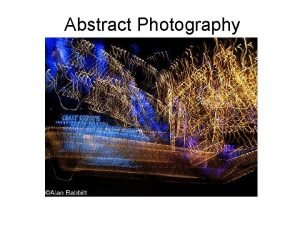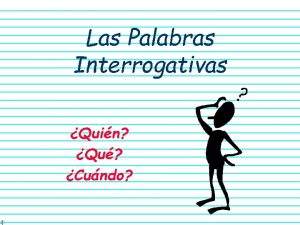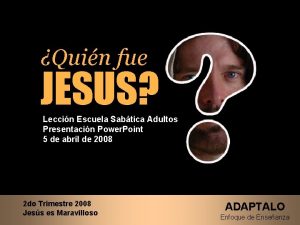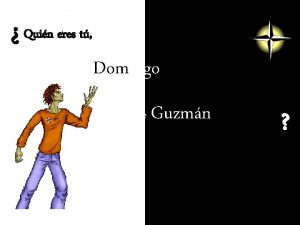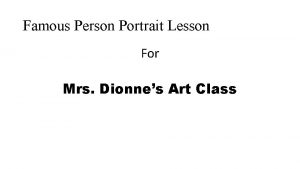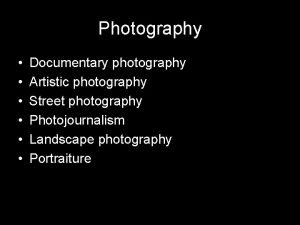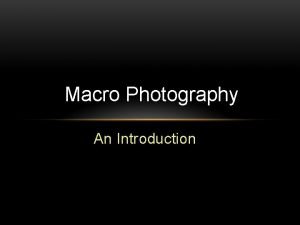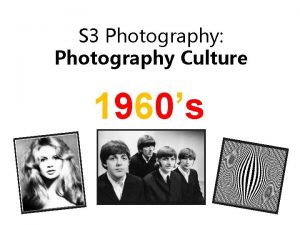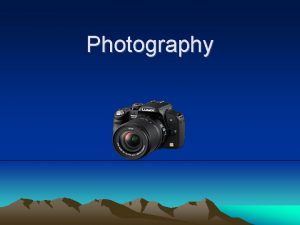PHOTOGRAPHY LESSON MRS QUIN DIONNES ART CLASSES PHOTOGRAPHY


















- Slides: 18

PHOTOGRAPHY LESSON MRS. QUIN DIONNE’S ART CLASSES

PHOTOGRAPHY LESSON 1)YOU ARE TO TAKE A SERIES OF PHOTOGRAPHS FOR EACH OF THE FOLLOWING 4 THEMES: Theme 1 - Its All About Perspective Theme 3 – Portraits 1, 2 3 A) It’s a GIANT B) I’m out of place B) 2 People C) The itsy, bitsy… C) 3 People D) Landscape Theme 2 - Emotional Rollercoaster A) Fear photograph B) Happiness C) Sadness D) Loneliness A) 1 Person Theme 4 – Snapshot VS Photo Take a picture of the same object with one being a snapshot and one being a

DIRECTIONS 2 -4 PHOTOGRAPHY LESSON • 2) Take your photos with your phone camera. You need to set up the pictures for each theme. See examples on the next slide. ** It is better to have too many photographs to choose from than not enough, so take a lot. • Ex. If I need 5 photos for a series, I need to take at least 10 to 15 which can be saved to a flash drive if needed. • 3) Print a montage of your photos for each theme. You will turn in 4 pages of pictures to the teacher. One page for each theme. Be sure to label each picture. • 4) Be prepared to discuss and explain your photos during a class critique when you return to class. • ** If you do not have a printer email the teacher your 4 montage pages. This Photo by Unknown Author is licensed under CC BY-SA

YOUR PHOTOGRAPHS NEED TO SHOW A UNIQUE ANGLE AND VISUAL PERSPECTIVE. YOU WILL BE GRADED ON YOUR CREATIVITY AND ABILITY TO VIEW AN OBJECT WITH AN ARTISTIC POINT OF VIEW. USE A PHONE CAMERA TO TAKE YOUR PICTURES. IF YOU DO NOT HAVE ACCESS TO A PHONE CAMERA, SEND TEACHER AN EMAIL FOR AN ALTERNATE LESSON. quin. dionne@cabarrus. k 12. nc. us

Please read and study the rest of the Power Point lesson to learn some key concepts in creating a photograph and understand the following information about taking a quality photograph. • a SNAPSHOT captures a memory • a Photograph is an artistic interpretation of an event, person or object that conveys a message or an idea to the viewer. It doesn’t just show an object but what an object is like. • a SNAPSHOT = points and shoots quickly • a Photograph pays attention to every detail, seeing the composition, knowing what is in the frame before you press the shutter. You work out the shot in your mind. It is slow and thought out.

snapshot SNAPSHOT VS PHOTOGRAP H Photograph

HERE A FEW EXAMPLES OF THEME PICTURES. CAN YOU GUESS WHICH CAPTION GOES WITH THE PHOTO? I’m out of place Sadness It’s a Giant

PHOTOGRAPHING PEOPLE PORTRAITS: THE BASICS

STYLES OF PORTRAIT PHOTOGRAPHY • Photography of people can be broken down into numerous categories. It is important for photographers to identify separate styles in order to choose the right creative direction for future projects. Being able to understand different styles will also help you to organize existing work in a portfolio. In this presentation you will explore a list of fundamental styles that relate to portrait photography.

1. Traditional portrait Traditional or Classical portraiture would refer to an image where the face is the predominant element. The purpose of the photograph is to depict visual representation of that person. Subject is expected to be looking directly at the camera. With what is described as a head-shot, two thirds or full body framing can be used.

2. Environmental Portrait The term Environmental Portrait refers to an image where the subject is photographed in person’s natural environment. For example, a worker photographed at the construction zone, teacher in the classroom, sculptor in a sculpture studio and so on. Surroundings are used to compliment the subject and to emphasize his character. Subject and setting are chosen by the photographer.

3. Candid Portrait A candid portrait is taken without a subject expecting or acknowledging the photographer. This style is used in photo journalism, travel photography, street photography and event photography. As opposed to an environmental portrait this image is captured at the moment rather than set up.

4. Glamor Portrait. The term Glamor Portrait refers to portraits where emphasis is given to highlight the beauty or romantic appeal of the subject.

5. Lifestyle Portrait The term Lifestyle Portrait refers to portraits where emphasis is given to suggest the “style of living” of the individuals depicted. Technically it is a combination of environmental portrait and candid portrait. More weight is given to communicate the feeling of life experience of the subject. Style has numerous implications in commercial and fine art photography. Editorial, fashion, pharmaceutical, and food industries often use lifestyle images to evoke emotions in viewers by depiction of desired life styles. It is common to see this style used in wedding and family portrait photography as well.

• 6. Surreal Portrait • Surreal Portraits are created to emphasize the other reality. • A depiction of a person’s interpreted subconscious mind. • Surrealism is an art movement started in the early 1920‘s and is still alive and well. It uses photography tricks and special effects to achieve a surreal look. VIDEO/ EBOOK: Photography Tricks and Special Effects

7. Conceptual Portraits refer to images where concept adds a fourth dimension. The hidden meaning of the concept will leave the viewer guessing as it is often open for interpretation. Conceptual artists generally get offended when asked what did they mean in their photograph. It is the job of the viewer to decide. Conceptual Portraits are often used in advertising photography but the concepts are much easier to understand. Photo by Constantin Gedal “Untitled” 2007

9. Abstract Portrait Abstract portraits are created with a purpose of creating art and not based on realistic representation of a person. Collage or digital manipulation is often used. Photo by Sasha Gitin. Portrait of Ura, 1999

CONCLUSION: STYLES MENTIONED IN THIS POWERPOINT ARE THE BASIC PRINCIPALS OF PORTRAIT PHOTOGRAPHY. EACH STYLE OR A COMBINATION OF ANY CAN BE APPLIED TO NUMEROUS CATEGORIES. FOR EXAMPLE A WEDDING PHOTOGRAPHER CAN CHOOSE TO USE TRADITION STYLE VS. CANDID OR GLAMOR VS. LIFESTYLE.
 They are mrs garcia and mrs castro
They are mrs garcia and mrs castro They are mrs garcia and mrs castro
They are mrs garcia and mrs castro Mrs. darling was ___________ of mrs. s.
Mrs. darling was ___________ of mrs. s. Mrs dalys reading classes
Mrs dalys reading classes Classes e subclasses de palavras pdf
Classes e subclasses de palavras pdf Pre ap classes vs regular classes
Pre ap classes vs regular classes Is abstract photography same as conceptual photography
Is abstract photography same as conceptual photography Más quin
Más quin Es quin
Es quin Quien fue jhon dalton
Quien fue jhon dalton Quin va
Quin va Todas las palabras interrogativas
Todas las palabras interrogativas Quin soy
Quin soy Quin lee
Quin lee Quin es jesus
Quin es jesus Eva mitocondrial
Eva mitocondrial Es quin
Es quin Quien ha visto a dios
Quien ha visto a dios Quineres
Quineres






